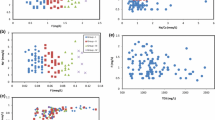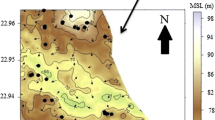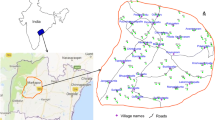Abstract
Fluoride in high concentration in groundwater has been reported from many parts of India. However, a systematic study is required to understand the behavior of fluoride in natural water in terms of local hydrogeological setting, climatic conditions, and agricultural practices. The present study is an attempt to assess hydrogeochemistry of groundwater in parts of Palar river basin pertaining to Kancheepuram district Tamil Nadu to understand the fluoride abundance in groundwater and to deduce the chemical parameters responsible for the dissolution activity of fluoride. The study area is geologically occupied by partly sedimentary and partly crystalline formations. A total of 50 dug cum borewell-water samples, representing an area of 2,628.92 km2. The results of the chemical analyses in September 2009 show fluoride abundance in the range of 1 to 3.24 mg/l with 86% of the samples in excess of the permissible limit of 1.5 mg/l. Presence of fluoride-bearing minerals in the host rock, chemical properties like decomposition, dissociation, and dissolution, and their interaction with water are considered to be the main causes for fluoride in groundwater. Chemical weathering with relatively high alkalinity favors high concentration of fluoride in groundwater. Villagers who consume nonpotable high fluoride water may suffer from yellow, cracked teeth; joint pains; and crippled limbs and also age rapidly.
Similar content being viewed by others
References
Apambire, W. B., Boyle, D. R., & Michel, F. A. (1997). Geochemistry, genesis and health implications of fluoriferous ground waters in the upper regions of Ghana. Environmental Geology, 33, 13–24.
Apparao, B. V., & Karthikeyan, G. (1986). Permissible limits of fluoride ion in drinking water in Indian rural environment. Indian Journal of Environmental Protection, 6, 172–175.
BIS (1991). Drinking water specifications: First revision, IS: 10500: 1991.
Boyle, D. R., & Chagnon, M. (1995). An incidence of skeletal fluorosis associated with groundwaters of the Maritime Carboniferous Basin, Gaspe Region, Quebec. Environmental Geochemistry and Health, 17, 5–12.
Brown, D. W., & Roberson, C. E. (1977). Solubility of natural fluorite at 25°C. USGS Journal Research, 5(4), 506–517.
Chatterjee, M. K., & Mohabey, N. K. (1998). Potential fluorosis problems around Chandidongri, Madhya Pradesh, India. Environmental Geochemistry and Health, 20, 1–4.
Chinoy, N. J., et al. (1992). Studies on effects of fluoride in 36 villages of Mehsana district, North Gujarat. Fluoride, 25, 101–110.
Choubisa, S. L., Sompura, K., Bhatt, S. K., Choubisa, D. K., Pandya, H., Joshi, S. C., et al. (1996). Prevalence of fluorosis in some villages of Dungarpur district of Rajasthan. Indian Journal of Environmental Health, 38, 119–126.
Das, S., Mehta, B. C., Samanta, S. K., Das, P. K., & Srivastava, S. K. (2000). Fluoride hazards in groundwater of Orissa, India. Indian Journal of Environmental Health, 1, 40–46.
Deshmukh, A. N., & Chakravarti, P. K. (1995). Hydro-chemical and hydrological impact of natural aquifer recharge of selected fluorosis endemic areas of Chandrapur district. Gondwana Geological Magazine, 9, 169–184.
Deshkar, S. M., Deshmukh, A. N., & Vali, S. A. (1999). Safe limit of fluoride content in drinking water in different climatic zones of India. Indian Journal of Environmental Health, 2, 17–20.
Gupta, S. C., Rathore, G. S., & Doshi, C. S. (1993). Fluoride distribution in groundwaters of southeastern Rajasthan. Indian Journal of Environmental Health, 35, 97–109.
Handa, B. K. (1975). Geochemistry and genesis of fluoride containing groundwater in India. Groundwater, 13, 275–281.
Jacks G., Sharma, V. P., & Sharma, G. K. (1980). Hydrochemical studies, SIDA-assisted groundwater project in Kerala—a report (pp. 1–5).
Kullenberg, B., & Sen, G. R. (1973). Fluoride in Baltic. Geochimica et Cosmochimica Acta, 37, 1327–1337.
Kundu, N., Panigrahi, M. K., Tripathy, S., Munshi, S., Powell, M. A., & Hart, B. R. (2001). Geochemical appraisal of fluoride contamination of groundwater in the Nayagarh district of Orissa. Environmental Geology, 41, 451–460.
Muralidharan, D., Nair, A. P., & Satyanarayana, U. (2002). Fluoride in shallow aquifers in Rajgarh Tehsil of Churu District, Rajasthan: An arid environment. Current Science, 83, 699–702.
Nawlakhe, W. G., Lutade, S. L., Patni, P. M., & Deshpande, L. S. (1995). Groundwater quality in Shivpuri district in Madhya Pradesh. Indian Journal of Environmental Health, 37, 278–284.
Periakali, P., Subramaniam, S., Eswaramoorthi, S., Arul, B., Rajeshwara Rao, N., & Sridhar, S. G. D. (2001). Distribution of fluoride in the groundwater of Salem and Namakkal districts, Tamil Nadu. Journal of Applied Geochemistry, 3(2), 120–132.
Ramesham, V., & Rajagopalan, K. J. (1985). Fluoride ingestion into the natural water of hard rock areas, Peninsular India. Journal of the Geological Society of India, 26, 125–132.
Ramasesha, C. S., Kumar, E. S., Suresh, S., & Kumar, A. R. (2002). Occurrence of nitrate and fluoride in groundwater and their impacts in and around Dindigul, Tamil Nadu, India.
Rao, N. S. (2003). Groundwater quality: Focus on fluoride concentration in rural parts of Guntur district, Andhra Pradesh, India. Hydrological Sciences Journal, 48, 35.
Rao, N. S., & Devadas, D. J. (2003). Fluoride incidence in groundwater in an area of Peninsular India. Environmental Geology, 45, 243–251.
Ray, D., Rao, R. R., Bhoi, A. V., Biswas, A. K., Ganguly, A. K., & Sanyal, P. I. (2000). Physico-chemical quality of drinking water in Rohtas district of Bihar. Environmental Monitoring and Assessment, 61, 387–398.
Shaji, E., Bindu, J. V., & Thambi, D. S. (2007). High fluoride in groundwater of Palghat District, Kerala. Current Science, 92, 240–245.
Sreedevi, P. D., Ahmed, S., Made, B., Ledoux, E., & Gandolfi, J. M. (2006). Association of hydro-geological factors in temporal variations of fluoride concentration in a crystalline aquifer in India. Environmental Geology, 50, 1–11.
Sumalatha, S., Ambika, S. R. A., & Prasad, S. J. (1999). Fluoride concentration status of groundwater in Karnataka, India. Current Science, 76, 730–734.
Susheela, A. K. (1999). Fluorosis management programme in India. Current Science, 77, 1250–1256.
Susheela, A. K., Bhatnagar, M., & Kumar, A. (1996). Status of drinking water in the mega city Delhi. In Proceedings of the 22nd WEDC (Water, Environment and Management Conference), New Delhi (pp. 1–3).
Wenzel, W. W., & Blum, W. E. H. (1992). Fluoride speciation and mobility in fluoride contaminated soils and minerals. Soil Science, 153, 357–364.
WHO (1984). Guidelines for drinking water quality, values 3; drinking water quality control in small community supplies (212p). Geneva: WHO.
Wodeyar, B. K., & Sreenivasan, G. (1996). Occurrence of fluoride in the groundwaters and its impact in Peddavankahalla basin, Bellary District, Karnataka—a preliminary study. Current Science, 70, 71–74.
Author information
Authors and Affiliations
Corresponding author
Additional information
A comment to this article is available at http://dx.doi.org/10.1007/s10661-013-3525-4.
Rights and permissions
About this article
Cite this article
Dar, M.A., Sankar, K. & Dar, I.A. Fluorine contamination in groundwater: a major challenge. Environ Monit Assess 173, 955–968 (2011). https://doi.org/10.1007/s10661-010-1437-0
Received:
Accepted:
Published:
Issue Date:
DOI: https://doi.org/10.1007/s10661-010-1437-0




